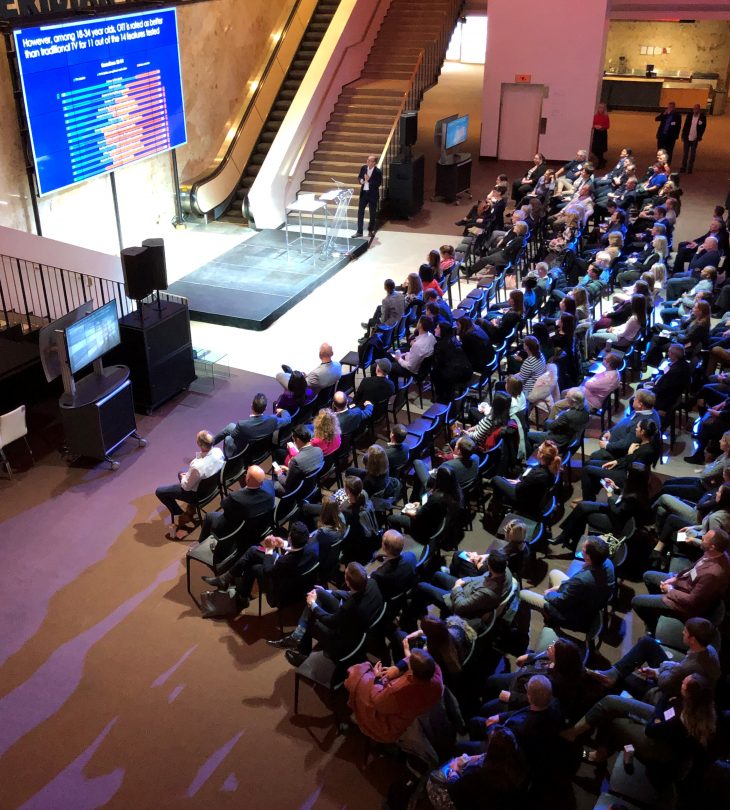
Flexible storytelling is the key to the future
TORONTO – Overall, Canadians are spending less time watching video content than in 2018, but 18-to-34 year-olds increased their overall viewing, while those 35 and over have seen a decrease in viewing hours, according to new research from CTAM Canada.
Further, 50% of Canadians are using an OTT (over-the-top) service to supplement a traditional TV subscription. They want more content, but find it difficult to locate it all with a traditional TV subscription – and they believe traditional TV is too costly. Subscribers to OTT report paying around $20 a month whereas those subscribing to traditional TV fork out around $74 a month, according to the research presented.
Overall “subscription to TV among Canadians ages 18 and over settles at 76%, with 48% of Canadians subscribing to both TV and OTT services and 17% subscribing only to OTT,” said Charlton Insights’ CEO Gord Hendren during the CTAM Broadcaster Forum held last week at the Meridian Centre in Toronto.
“The likelihood that those ages 35 and over have a paid TV subscription (according to findings 35% subscribe to TV only) is higher. Yet, for 18-to-34 year-olds the story flips the other way where OTT is dominant, meaning 84% of 18 to 34 years-olds are subscribing to any OTT, 62% to TV,” added Hendren. Only 9% of those ages 18 to 34 subscribed to only TV in 2019.
Traditional television continues to win when it comes to live sports, of course, since the games mostly still live there. Online performs better with linear content which can be accessed away from home and without interruption.
Hendren stressed that many Canadians cannot tell the difference between TVE (“TV Everywhere”) such as the Shaw BlueCurve TV app and services like Netflix so, “in the end it just matters if they use it.” He argued “paid TVE is a loyalty driver,” and sees opportunity for business and industry to better communicate and educate consumers about the benefit of using TVE because “at this moment OTT is winning in terms of the perception value.”
The way to ignite TV, he says, is through “seamless integration of the sources,” while also considering cobranding. Platforms like Crave have already capitalized, serving both TVE and OTT offerings under the same brand.
Branding and perception can usher in more growth and, as industry content strategist Laura Mingail noted during her presentation on November 18th, also create more opportunity for customized experiences using product integrations.
Dating app Tinder, for example, “is already producing interactive content with plans to customize what advertised products are inserted into the content based on exactly who’s watching,” Mingail said during her keynote address. News and weather reporting could be a ripe place to test out augmented content, too, she added. Using green screen, reporters could be augmented and catapulted to different locations, or put inside branded environments, which would no doubt excite advertisers.
“You can also augment the viewing experience and have stories come to life in people’s homes,” said Mingail. “And soon AI will be able to customize storylines to what people are interested in.”
She said Disney is developing a solution “where it automatically converts what is written text in script to action by using game engine,” which can then be viewed in virtual reality or as linear content.
Places like Flipside Studios are converting live action to real-time animated content that you can live stream onto YouTube or Twitch. “All you need is a standard VR headset, access to their software, some creativity and an internet connection,” she added.
The “screenless screen” is also being explored by brands, notably with augmented reality glasses. Mingail said it needs to “feel intuitive” and soon content could be judged based just on sentiment. By making the tech track eyes, voice, and gestures so it’s more intuitive, greater simulated storytelling can be experienced. But, with that comes the importance of knowing when and where people want to use voice, for example, to interact with platform content, she said.
Digital beings, a.k.a. those powered by AI, are given personalities and memories, and Mingail says there’s great potential here, too. During SXSW, Amazon Studios set up a virtual world based on its hit series Good Omens where people could hang out while story characters roamed about. The film Finding Jack will bring James Dean back to life in 2020, and content with a virtual being (Wolves in the Walls) won its first Emmy this year.
Selling more than the finished programming is something to think about as well.
“Maybe five to six years down the line you could be selling the rights to virtual beings and their stories,” she says. Unlike real celebrities, “evolved virtual beings will have the ability to interact with a limitless amount of fans on multiple platforms as they’ll know who you are and they’ll have memories of interacting with you.” This type of technology is expected to come out early 2020, according to Mingail.
“Brands are now extending storytelling beyond 30 or 60 seconds, or two minute spots, to full films. And agencies like Media One are developing branded films, something that most traditional agencies are not yet set up to do.”



